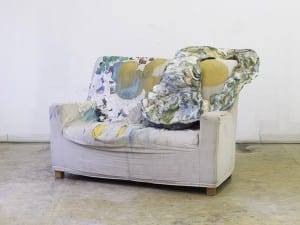Entering through the sliding doors of the ICA, a perceptible chatter drifts around the corner from the gallery’s ground floor exhibition space. It sounds as if the private view of the show is still underway. However, approaching the stairs to look down into the gallery, the space is empty except for seven pairs of white, flat-panel speakers, held taught at head height by thin wires stretching floor to ceiling. This is the UK premiere of Bruce Nauman’s piece, Days (2009).
The speakers form a corridor in the space, two opposing rows of suspended white squares. Stepping down into the gallery you feel obliged to enter the thoroughfare. The previously unintelligible chatter clarifies. Standing between the first pair of speakers a woman’s voice is heard. She appears to speak from two places at once; separately yet concurrently, savouring each word both voices carefully pronounce the days of the week in no particular order. Sometimes speaking over one another, sometimes conversationally filling each other’s interludes. Although the remaining six sets of speakers are now close by, the voices they project remain indistinct.
The next pair of speakers plays the voice of a soft-spoken American man. He too vocalises the days of the week out of order, but he speaks faster and with greater clarity. After him we meet five others, including a young boy who rushes, slightly breathless, through the words, and at the far end, and older man whose languorous recitation is comparatively calm. At each point the coherence of the previous voice fades away and a new person is introduced, yet the viewer remains to be confronted with the banality of these seven words.
The terms are over-familiar, used to dissect and punctuate the passing of time in a way that can be understood with no need for thought. Nauman’s choice of text would seem abstract with regards to direct prose-like coherence, yet it feels familiar. Amidst the chatter of a private view the words and their effect would not be so different; the discussion pervading the room, bouncing off of the white walls, seems stimulating as a whole, but to step into just one conversation is not far removed from the experience Nauman’s piece presents. There is an unavoidable and very human obsession with the trivialities of time; conversation constantly peppered with references to dates; which shows opened last Wednesday, and which will close the following Monday. There is a disjunction between the abstract complexity of the passing of time, and the commonplace terms in which it is conveyed.
In the ICA’s upstairs gallery space is a second exhibition, SOUNDWORKS. The show is pitched as both a survey of current sound art and a response to the Nauman piece being shown below. 100 sound works have been selected, and are held on an online platform. The platform can be accessed both via the internet and in the gallery space. The room is bare except for a black, square, foam-topped seating arrangement at its middle. A disguised iPad is embedded centrally in the platform. On the touch screen, the works are listed alphabetically by artist, and the viewer is invited to pick and listen to any or all of them. Upon arrival the screen is in the hands of a group of American tourists. The first piece I witnessed is Selçuk Artut’s vocal work 107 people 1-100. Taking the simple act of counting as a starting point, the piece begins with just one voice counting up from one, however, voices are added, building up exponentially until the act of counting is no longer present, and all that remains is a dull rhythmic clamour; the ties to Nauman’s piece are immediately apparent.
As the noise begins to escalate, the track is changed, and Robert Wilhite begins a matter of fact description of a theatrical event containing a series of unique musical sculptures (A Geometric Instrumental). The track flits again and a grotesque character of Nathaniel Mellors’ invention begins to provide background information on Bruce Nauman, punctuated by rhythmic distorted keyboard interludes (Northern European Erection). This piece doesn’t go down well with the tourists. The next piece selected is Agnieszka Polska and Tomasz Kowalski’s hauntingly beautiful vocal composition, Nothing Twice. My company in the room leaves, and this piece is allowed to culminate uninterrupted, “just us, two drops of water, are.”
The sound works represent a vast array of auditory modes, and in their culmination they form a remarkable archive with no specific need to reference Nauman’s work. However, taken together, these two sound exhibitions both transcend their mechanics. The audience participation and engagement in SOUNDWORKS leads to a negotiation between separate viewers, and an exchange between audience and work. In its description, Nauman’s piece would appear mechanical in its devices, yet when presented in a gallery it has an immediate, human quality. The spatial negotiations of the piece force a separate engagement with each set of speakers. It becomes apparent that the words have been ordered by individual improvisation, independent of a proscribed script. Even within the monotony of the verbal limitations an individuality is present in each of the performers. When you step back from the piece and the voices once again become a wash of conversational sound, a personal resonance remains.
Bruce Nauman: Days, 19/06/2012 until 16/09/2012, ICA, The Mall, London, SW1Y 5AH. www.ica.org.uk
View SOUNDWORKS at: www.ica.org.uk/soundworks
Credits:
Installation view of Bruce Nauman’s Days, ICA. Photo: Stephen White. Courtesy of ICA
Days is presented at the ICA on loan from Emanuel Hoffmann Foundation, gift of the President, on permanent loan to Öffentliche Kunstsammlung Basel, and The Museum of Modern Art, New York, Committee on Painting and Sculpture Funds, gift of The Mimi and Peter Haas Fund, Agnes Gund, The Hess Foundation, Michael Ovitz, Jerry I. Speyer, Marie-Josée and Henry R. Kravis Foundation, Donald B. Marron, and The Jill and Peter Kraus Contemporary Acquisition Fund.
Text: Travis Riley



